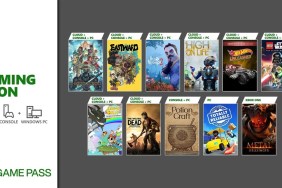With gigantic melancholies and gigantic mirth.
It is hard to encapsulate Age of Conan: Hyborian Adventures in a few paragraphs. Drawing from Robert E. Howard’s most famous work – the setting and the characters – automatically paints a world of "might making right", of personalities of such magnitude that their every motion shakes their world in mirth or anguish. Communicating that in a game is not a trivial proposition: How do you set players into a world that ripples with the extremes of their play?
[image1]Age of Conan approaches this problem by placing players into a free-for-all of biblical proportions. Wandering the desolate realms of PvP servers, it quickly becomes clear that there are few ways to thrive without a guild to protect you. This is not unusual for MMOs, but in a game designed to be in a setting that takes place in the solitary strivings of Conan’s world, where the strong kill the weak for the simple joy of it, it’s schizophrenic. The language, the art, and the storyline evoke a world of individualistic triumphs and defeats, but yet it tries to push you towards co-operative play.
It is all the more curious that the game defines four broad archetypes, splits each archetype into three classes, and then provides feat trees that blur the lines between the classes. Why is the barbarian, a class with a very high damage output and hit point total, a class with abilities geared away from stealthy play, archetyped as a rogue? Why is the Herald of Xolti, a priest archetype that eats the hearts of his foes and transforms into a Great Old One, not a spellcaster of some sort? It is very confusing, and given how easy it is to gear your character to fill roles other than what an archetype or class mandates, it casts a lot of gray into the notion of well-organized co-operative play.
The single most enjoyable aspect of Age of Conan is the combat, which is approached from an interesting perspective. Regardless of class, all characters have three fundamental attacks, each corresponding to a direction. Likewise, all classes have essentially three defense points that they can shift across those three directions. Strike a foe where he is poorly defended, and you will cause a critical amount of damage. Hit a foe where he has his defense points stacked up, and your hit will be useless. On top of this, there are combos for melee classes that require you to enter a series of these attacks. It’s an engaging, fast-paced system that makes playing the melee classes much more fun moment to moment than any other MMO I have played.
[image2]Without U.I. tools to evaluate targets – beyond knowing which class they are and what their level is – PvP play involves an awful lot of guesswork and research. To evaluate your chances, you need to go out and find out what the ideal items for a class of that level are, and you need to learn a great deal about the builds. The consequence is that there’s no clear way to gauge if you can win or lose a given fight other than to jump in and try it.
This does level the playing field, albeit in a strange way. It becomes possible for a well-built character eight levels below you to topple you, and vice versa. Level becomes somewhat less significant (within reason) than build and equipment. Of course, if there’s a 10-level difference between players, the equipment ranges change dramatically enough that it becomes clear who the victor will be, but unlike the WoW experience where three levels is enough to clean your chronometer, Age of Conan leaves the arena floor open for a much wider span.
Outside of PvP, Age of Conan is much the same MMO you’ve played a dozen times already: fetch and extermination quests galore, with the occasional interest-of-the-week thrown in. The game is at its strongest while leveling up to the 20th level or so, when there is a firm narrative and a real sense of personal accomplishment. Sadly, that makes up roughly six hours of playtime; after that, you’re thrust into a brutish world of roaming rape squadrons and classic MMO grinding.
[image3]Adding insult to injury, many quests are bugged. Much of the game’s center, roughly the 50+ level arena, is devoid of content that isn’t broken. With a crafting system from Lovecraft’s worst nightmares, involving factories and mining, and a truly uncivilized regression in voice acting which devolves into a silent world soon after reaching level 20, Age of Conan begins to falter soon after the first blush.
Though Age of Conan does present some stunning visuals, the quality is not so amazing that it justifies the intense system requirements. Age of Conan is not kind to mortal computers, and the numerous memory leaks and bugs will bring most older systems to their knees. Age of Conan frequently occupies 300 megs of memory in the background after closing it, requiring it to be shut down from the task manager; as an experiment, I left my computer sitting like that for two days once, and was surprised to discover that Age of Conan was still sitting there in memory.
Age of Conan shows an awful lot of promise; there is, behind the bugs and balance issues that will hopefully be patched up, the kernel of a very good MMO. The problem is that potential is not the same as value, and it’s hard to recommend Age of Conan as it stands right now. In six months, however, it should be spectacular.
-
Engaging melee combat
-
Dull, same-y combat for caster classses
-
Fairly level PvP
-
Poor UI support for PvP
-
Excellent visuals
-
Painful system requirements
-
Crafting is a nightmare










